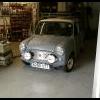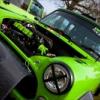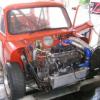Running Fuel, Brake And Power Inside
#1

Posted 25 August 2010 - 08:38 PM
i have decided that i am going to run the fuel line, brake line and the power line on the inside of the car and i am wondering if people have already done this and also how it was done?
would like to know how people have secured them, which direction people have went with them and what was used etc.
pics would be very helpful
also does the fuel line have to be solid or can a full length rubber pipe be used?
thanks in advance for any replies
#2

Posted 26 August 2010 - 11:52 AM
I am going through this process at the moment. I would use solid pipe through the car as normal rubber or braided rubber will give off a fuel smell and leave you with a headache!!
I'm using Goodridge hardline in -6 which is very nice. You can also use Goodridge 811 series hose, this is PTFE lined rather than rubber (its expensive though!)
#3

Posted 26 August 2010 - 03:29 PM
hope this helps.
#4

Posted 26 August 2010 - 04:42 PM
#5

Posted 26 August 2010 - 05:03 PM
The fuel line is on the outside of the car for a reason, I would suggest that you keep it there!
#6

Posted 26 August 2010 - 05:10 PM
#7

Posted 26 August 2010 - 05:35 PM
Dave
Attached Files
#8

Posted 26 August 2010 - 09:20 PM
They have to be inside on rally cars or they would just get ripped right off on the first rough road. I always run mine down the central tunnel to prevent damage in side impact collisions or crashes. In 49 years of rallying I've never seen a properly installed internal metal fuel pipe fracture in a Mini, even in really big crashes.
Track car or rally car there is clearly a need for an internal fuel line in motorsport. But motorsport is a very different environment to the road, with different hazards and very different safety measures. In a road car there is no such need for an internal fuel line and therefore to bring it inside the car and closer to the occupants it is an unnecessary risk, regardless of how indestructible you may consider it to be. I can't comment on rallying collisions as I have no experience of them, but in road traffic collisions I have seen not only fractured metal fuel lines, but floor pans ripped away, chassis's twisted through 90 degrees and secured structures inside vehicles displaced by several feet (more than enough force to fracture the very strongest of small steel pipes).
Those people who fit internal fuel lines in road cars should maybe consider that they are not only exposing themselves to a completely unnecessary risk, but also exposing those of us who have to pull them out of the wreckage when it all goes wrong!
#9

Posted 26 August 2010 - 09:32 PM
#10

Posted 26 August 2010 - 09:37 PM
#11

Posted 26 August 2010 - 09:58 PM
actually had a look at DaveJFs before i started mine

battery starter cable off ebay http://cgi.ebay.co.u...e=STRK:MEWNX:IT
p clips obviously different sizes for fuel lines/battery cable/brake pipes
http://cgi.ebay.co.u...e=STRK:MEWNX:IT
My car will be used alot on the road in the summer, Not sure if id do it if it was a high mileage everyday car.
im not saying its a good or bad idea, iv done it myself but thats because i want to take it on the track.
as Dave said definatly run them down the centre
Dont use rubber just use copper, rubber is just an accident waiting to happen
Consider your passengers safety
#12

Posted 26 August 2010 - 10:12 PM
So, if an external fuel line is broken off, it is far more likely that petrol will get onto the exhaust as not many exhausts run inside the car. I always run my petrol lines inside and have done since I started rallying back in 1960. My background is in aviation, where safety is far more considered than in automotive engineering.
Rallies are, or used to be, long distance events with a lot of quick road driving. There has never, to my knowledge, been an accident where death or injury has happened due to failure in a crash-case of a properly installed (i.e. in acordance with FIA requirements) internal fuel line. In a crash where the basic structure is significantly deformed, the main risk is the G-force. The cause of a fire is then more likely to be broken hydraulic lines in the engine bay and fuel feed lines adjacent to the engine.
The regulations for motorsport, including long-distance rallies are clear on how internal fuel pipes are to be safely installed.
#13

Posted 27 August 2010 - 07:16 AM
Cooperman is right that the combustion point of fuel is high compared to hydraulic fluid and is more likely to cause a fire (this is not to be confused by the spark point). I run braided fuel lines as well as brake and pow on the inside of my racer, but all my road cars have everything external. This is mainly because the risk of peoples feet damaging stuff is higher than any likely damage on the outside. Also with a car with a proper interior I don't want it ruined with even a minor leak.
Every accident is different and there is no actual evidence (other than anacdotal) to support either argument as a safety issue. But common sense says if you do run them inside, avoid joints where you can (non in fuel lines) and run them down the middle not the sill.
#14

Posted 27 August 2010 - 08:17 AM
i do agree with AVV IT on this one, keep the flammable stuff on the outside of your tin box, not in it with you. im going to run everything but the fuel line inside.
Err, you know brake fluid is made from oil right? And PVC insulation is pretty flammable too.
#15

Posted 27 August 2010 - 09:06 PM
1 user(s) are reading this topic
0 members, 1 guests, 0 anonymous users





















